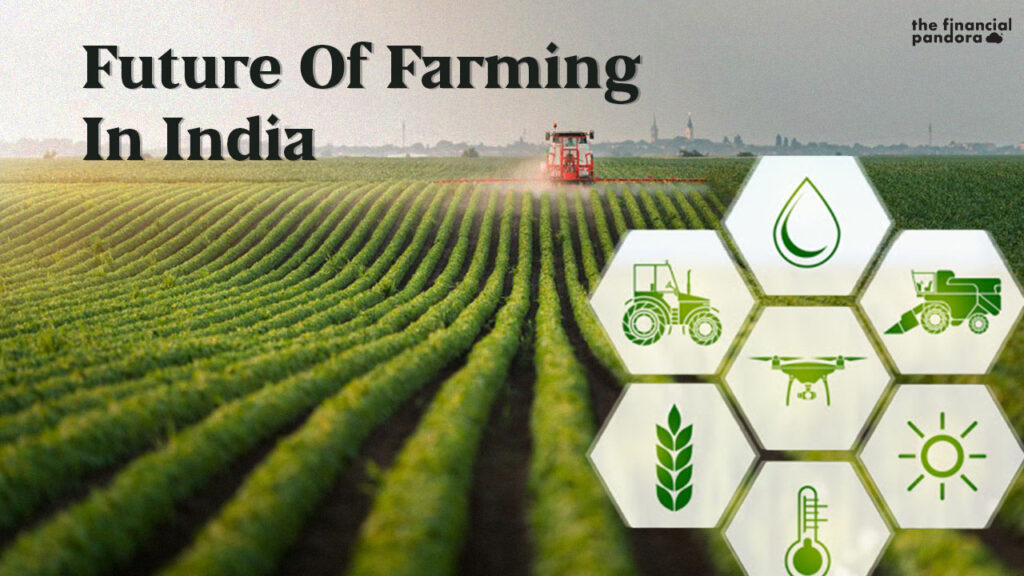Let us first understand how the agricultural value chain works. You are a farmer who owns less than 2 hectares of land (among 88% farmers in India). Based on last year’s prices, you decide to sow wheat. However, when your crop is ready after 3 months, you cannot sell to anyone you like. So, if you are among the lucky 40% who have access, you make your way to the nearest government-regulated mandi (Agricultural Produce Market Committee or APMC), the only one place you are legally allowed to sell your crop. You give your cleaned, sorted and weighed product to the auctioneer who puts it on display on the market platform. APMC registered traders, interested in your product, gather around and start bidding. The highest bidder eventually takes home your crop after you settle the transaction with the buyer. This buyer can then transport and sell it to food processors, retailers or at APMCs in larger cities.
The above narrative looks good on paper – APMCs are supposed to be regulated multi-buyer multi-seller multi-commodity markets which facilitate local price discovery, improve bargaining power and provide procurement options to farmers. However, in reality, APMCs are rent-seeking and monopolistic in nature leading to traders walking away with the lion’s share and the farmers getting 25% of the price paid by the end consumer, at best.
Even being a trader in India is not without risks. While the government is expected to regulate the supply of food items only under extraordinary circumstances (under the Essential Commodities Act (ECA), 1955), this remnant post-independence legislation, created to address food shortage and famines in India, included wheat, rice, cereals, pulses, oilseeds, edible oils, potatoes and onions as essential commodities. Moreover, stock limits can be imposed under the ECA, forcing people who have stocked essential commodities beyond the limit to sell them in the open market. This uncertainty over stock holding limits, leads to traders staying away from creating supply chain infrastructure which in turn leads to increased price volatility for end consumers as well as producing farmers and loss of perishable harvest.
While wholesaling, processing, logistics, and retailing are rapidly evolving through the intervention of entrepreneurs, the “back end” activities of production have been continuously fragmenting. The government has passed 3 Farm bills in September 2020 to address these linkage issues. Given these interventions, what does the future of farming look like in India?
Since 2015, starting with the Shanta Kumar Committee Report, the government has been trying to restructure the Food Corporation of India, dismantle India’s notoriously inefficient Public Distribution System (‘PDS’) and focus on direct cash transfers to ensure food security. This would eventually mean making minimum support prices redundant, the agricultural product price set by the Government of India to purchase directly from the farmer to safeguard the farmer to a minimum profit for the harvest. This would only be achieved by increasing competition to drive better prices for farmers, hence the move to remove mandis from acting as restricting gateways and inviting private players (cold storages, warehouses, processing plants, restaurants or end consumers) to provide alternatives to farmers through forward contracts. Sounds simple enough, right?
The laws clearly lay out a framework for increasing competition – allowing intra-state trade and inter-state trade, providing contract design and penalties to mitigate breach of contract. Let’s look at its impact on the decisions to be taken by farmers — what to sow, how much to invest.
- What to sow?
The legal environment for contract farming, with the assurance of a price (based on projected future market prices by corporates) to the farmers at the time of sowing, will help them take cropping decisions based on forward prices. This will increase household income and mitigate market risk, protecting the farmer from cyclical prices of agricultural products.
- How much to invest?
Long-term contracts with farmers will justify higher investments on farms through increased farm mechanization and faster shift to high value products such as horticulture and fisheries. This move can be further accelerated through agricultural advisory services, provision of inputs and credit support by corporates.
Companies which enter into contracts with farmers can reap the following benefits:
- What to store?
Coupled with the removal of warehousing caps under Essential Commodities Act, companies can adopt a market based warehousing system to stock up on goods based on forecasts of future shortages, and trading prices.
- How much to charge?
Better control on the quality and traceability of products can help firms tap into the trend of greater consumer awareness about food safety and hygiene in the domestic market. This also opens up the scope for international trade with ITC planning to create export-oriented fruit and vegetables clusters.
Of course, the ground reality is not that straight forward. The starting assumption for allowing farmers to sell outside APMCs is that APMCs were present throughout the country in the first place. However, the markets do not exist uniformly throughout the country – the procurement system reaches 11.8% of Indian farmers. As evident by protests breaking out in Punjab, Haryana and Western Uttar Pradesh, these are the places where the government procurement infrastructure is very good (95% farmers in Punjab and 70% in Haryana are covered, compared to 7.3% in West Bengal) and farmers are apprehensive of existing markets getting diluted. Moreover, the farmers who benefit from the government procurement process and MSP are medium and large farmers, not the marginal ones who consume their own produce and buy some more from the market. Moreover, there are concerns about large corporations exploiting marginal farmers through contracts.
So what does the future hold? While allowing farmers to sell outside the rent seeking APMCs is a good move, removing APMCs might not be the answer. Even the success of ITC’s e-Choupal model banks on having strong local primary wholesale markets as an alternative to farmers. The plight of farmers in Bihar, after the abolition of the APMC Act in 2006, should serve as a cautionary tale for us. India is vast and heterogeneous and bears similarities with the EU. Hence the government needs to step up if it wants to create a national market. Economic enterprise can only go so far, common markets require significant political and financial investments with strong focus on implementation – creation of regulatory institutions to coordinate trade between states, creation of physical infrastructure – roads, power supply, cold storages and market places for private players, making access to global markets easier and rethinking India’s agricultural insurance and farm credit strategy. Even smaller steps like kisan credit cards and assistance in building FPOs might help.
While politicians may struggle, agri-tech might find a way to restart India’s sleeping giant. Godrej Agrovet set up a dedicated fund to invest in the space with an initial corpus of $50M in Sep 2010. CropIn and Stellapps developed B2B tech solutions focused on medium-large farmers. More than 12 agri-business incubators launched by 2015 and 100 agri-tech products generated cumulative revenue of $1.5M.
Agri-tech players are working across the value chain, from farm input selection, procurement of produce to creating farm to fork consumer brands. According to an EY report, the Indian Agri-Tech industry represented a market opportunity of $24Bn. Between 2016 and 2019, around $585 million was poured into agri-tech startups. WayCool, Ninjacart, DeHaat and PayAgri Innovations have created alternatives to the existing markets for both farmers and large buyers and strengthened market linkages. Bijak, Procol and AgriGator are solving for information asymmetry and lack of accountability in the value chain for agri-commodities. Sammunati is improving access to finance for farmers while EM3 Agri provides shared equipment and pay per use farm services model. Hyperpure (Zomato), Fresho (BigBasket), Licious and FreshtoHome are working to create new farms to fork consumer brands. Intello Labs is using AI and ML models for disease recognition and crop advisory while Tartansense has been providing automated pesticide spraying and weed management. Indoor farming through hydroponics has also broken through in a huge way, driven forth by Barton Breeze, Urban Kisaan and BitMantis.
India’s fragmented and opaque agricultural sector is ripe for disruption. And with these startups stepping in, we can be sanguine about the future.
Follow Us @




